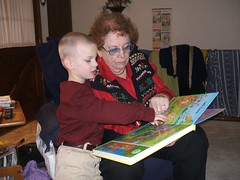Garage sales, tag sales, thrift sales . . . sales of used items have a lot of names. Whatever you call them, they’re lots of work, and often even fun. One person’s trash is another person’s treasure, and while the seller rejoices in cleaning house, the buyer enjoys a new find – often at a bargain price.
Our library just finished another booksale today – a garage sale of books. Or in our case, a basement sale, since the sale took place in the basement of a library. We haven’t had one in quite some time, and we found out the public really missed the sale. The first day we sold the items at a unit price. The second day was a bag sale. Tonight, there are very few books remaining that will be donated.
Throughout the sale, I watched people pouring over the tables of books, so weighted down I’m surprised they didn’t bend even a little. Almost everyone bought something, and most left with their arms full and smiles on their faces. What they were purchasing has been in the libraries, sometimes for years. They could have checked it out over and over. But there’s something special about taking books home when they’re yours. There’s something magical about owning books, and it appears for lots of folks, the more books the better. Tonight I’m imagining those people, emptying their bags and lining up their books.
I’ve been doing a lot of thinking about book format and ownership in the last few months. A marketing explosion by E-book vendors has pushed us into a world for which I’m not ready — and our library budget isn’t fully prepared. But here we are, staring E-book service in the face. Buying E-books is at the expense of our print budget. The media and sellers of E-books tell me “don’t worry, all the public wants is E-books anyway.” But as I watched those people, delighted with their purchases, I have to wonder. Is there such a thrill in ownership of E-books? Can I line them up? Can I admire them? Can I feel smarter just by being in their presence? Can I impress my guests by my walls of recorded knowledge? Or even more importantly for me and my family and friends, can I walk to the shelf in my home and pull down a tome and offer it to another person, thereby sharing the joy I found in reading it?
I haven’t settled my mind about the whole E-book phenomenon. It’s probably the first time in the technology revolution that I’ve found myself in the hanging back crowd. I do have an E-reader (of sorts). I have Kindle installed on my Droid cell phone. And I must admit that I’ve enjoyed having a book at hand on my Droid, especially when I was waiting – for a pizza, or a train to pass, or to be called into the doctor’s office. I even liked the backlit screen I could easily read while driving at night (actually, I was the passenger). But all my serious reading thus far has been print.
I’m still pondering all of this. I think the book to be written about E-books is only in its early draft stage. As a library leader, I embrace the challenge of providing what the public wants (today) and marvel at the capabilities of the devices. As a person, I worry over the possible sociological impact of the loss of the sharing of a physical object.
As for me at the book sale? Nope, I didn’t buy any. But, my husband and I made a side trip to our wonderful independent local book-seller. I bought a new book and he bought a used book. Sigh. Need to think about expanding our bookshelves.


